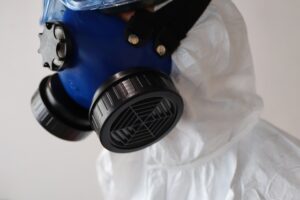What to Do in Case of Biohazard Emergencies?
 ‘Biohazard emergencies’ isn’t a phrase any of us want to hear on a regular day. However, despite the low probability, the chance of it happening does exist, and you need to at least be prepared for when it does. Knowing SOPs will help you ensure your safety and the safety of people around you.
‘Biohazard emergencies’ isn’t a phrase any of us want to hear on a regular day. However, despite the low probability, the chance of it happening does exist, and you need to at least be prepared for when it does. Knowing SOPs will help you ensure your safety and the safety of people around you.
On average, 320,000 people die globally each year due to exposure to biohazards at work, over 50% of them belonging to healthcare or social welfare sectors. Despite the numbers, most of us don’t know how to respond to a biohazard emergency. Since awareness is the first preventive measure, we have prepared a short guide to help you know more about the topic.
What Is Biohazard?
According to Merriam-Webster dictionary, a biohazard is “a biological agent or condition that is a hazard to humans or the environment.” Biohazards are common in fields that require biological work, especially with microorganisms.
Infected blood, bodily fluids, cell lines are examples of biohazardous waste and are considered a threat to the public.
Types of Biohazards
There are several types of biohazards, some of which are listed below:
- Viruses
- Fungi
- Spores
- Toxins from biological sources
- Pathogenic micro-organisms
- Bio-active substances
What Qualifies as Biohazard Emergency?
You now know what a biohazard is and its several types. However, what constitutes a biohazard emergency? A biohazard emergency results from the accidental or intentional spilling of biohazardous waste that can put a sizeable population in the area at risk.
Biohazard emergencies usually occur:
- Due to accidental release of biohazard waste at clinical facilities or laboratories.
- During the transportation of the material.
- At the time of discovery.
- By the intentional release of biohazardous material as an act of bioterrorism.
Basic Guide for Responding to Biohazard Emergencies
Following are some of the steps you can take to stay safe during a biohazard emergency.
In Case of Spills
If you encounter a biohazard spill, follow the steps mentioned below:
- Hold your breath and keep your distance.
- Quickly move out of the room and secure it, letting aerosol ventilation dilute the waste.
- Since you are potentially contaminated, you need to stay in the area and ensure other contaminated individuals do the same.
- Wear necessary protective gear (gloves, coat, and eye protection) before moving back into the room after 15 minutes have passed to clear away the contamination.
- Carefully clean the area using an absorbent material like paper towels.
- Apply a disinfectant to the same area and let it sit for 10-15 minutes before cleaning. Take extreme care to ensure the disinfectant does not splash outwards when you pour it out.
- Pay attention to any broken substances around and clear them away, leaning where they were resting.
- If you are uncertain about handling the contamination, call 911 Restoration at (234) 235-6624 and explain the situation to the team. Our members will reach you within 45 minutes of the call with the right equipment.
Once you’ve cleared the contamination, discard your coat, eye protection, and gloves. Immediately move to a space where you can shower and try to get a fresh set of clothing arranged as your current clothes may already be contaminated.
Shower for at least 15 mins, clearing your eyes, nose, and face thoroughly. Once done, get a medical check-up, just to be sure.
In Case of Exposure
Exposures refer to coming in contact with the biohazard waste directly. If you may have gotten exposed to a biohazardous waste, you need to take the following steps:
- If the biohazardous waste is on a piece of clothing or equipment touching your skin, mucus membranes, or skin, you need to remove the clothes. Put them in a red biohazard bag to indicate direct exposure.
- Wash all your exposed areas, like skin, eyes, and nose, etc. Wash the skin near the spill contact with soap and water to ensure it is clear.
- Keep a safe distance from other people to avoid contaminated them as well.
- Once the main scare has subsided, rush to the hospital facilities to get yourself checked for possible diseases.
- Inform your supervisor and submit documented proof of your exposure. Report any unusual findings in the medical report.
- Make sure your contaminated clothes are washed and disinfected on site before you take them. Do not remove contaminated clothes from the facility. If the facility does not allow washing, you need to discard the clothes as bio-waste.
Wrap Up
Overall, a biohazard emergency can be a daunting experience, but you have better chances of coping if you know the protocols. We hope this article prepares you for responding to a similar scenario.
If you encounter a similar situation but do not have the necessary materials, stay away from the area and call 911 Restoration. Our technicians are trained experts and will follow all necessary procedures to secure the spill. You can contact us by calling at (234) 235-6624 or clicking on this link.


